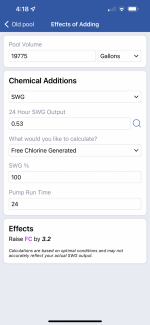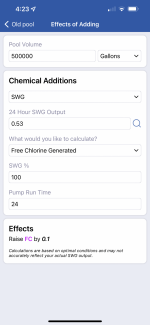I've seen a lot of mention that a salt pool wants a higher CYA level of 70ish, but can't find any explanation of *why*. Is there a writeup somewhere that someone can point me to? It's a bit confusing to me, because it seems like CYA protects the chlorine, but also requires me to have more chlorine, so why wouldn't I just keep the levels of both lower? If CYA sequesters chlorine and makes it unavailable... that doesn't seem like something I'd want.
Does it matter if my pool is in the woods and gets fairly little direct sunlight, but lot's of leaves bugs and dirt? I think I only get about 2 hours of full direct sun on the pool a day (which is nice, but also chilly).
Does it matter if my pool is in the woods and gets fairly little direct sunlight, but lot's of leaves bugs and dirt? I think I only get about 2 hours of full direct sun on the pool a day (which is nice, but also chilly).



